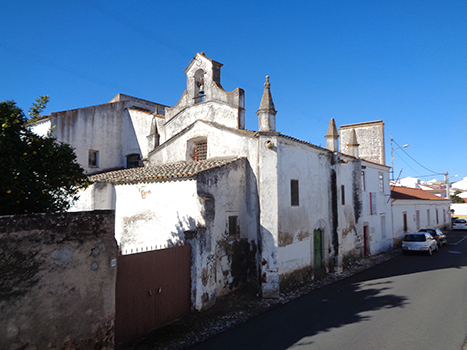 |
The church, located in the street that receives its name - of the Graça -, is part of the edified set originated by the oldest Viana’s institution known by present historiography. Still before the year 1319, Fernão Martins, his wife D. Maior, and their children founded in this spot a hermitage and a lodge or hospital invoking Santa Maria. Lodges or hospitals were intended to receive pilgrims and poor people, to whom Christian morality and social rules prescribed hospitality. It was not until the late 15th century that hospitals were characterized by the specific reception of sick people. Thus, this type of foundation was common among Christians, with the aim of promoting soul salvation through the works of charity practiced in life.
On 8th June 1319 was founded, in the same space, the confraternity of the Homens Bons Ovelheiros (The Good Men Sheepherders), which began to administer the lodge, managing all its goods. The confraternities were associations of Christians for the practice of charity, reason why, generally, they had attached hospitals or shelters. In the case of Viana, it is a confraternity of “good men”, that is, of the locality’s most prominent individuals, the richest and most powerful, among whom those who held the positions of the city government were chosen. This confraternity also reunited those who held the same office, who were livestock farmers.
Among the institution’s patrimony in the 16th century we can find houses, small lands for cultivation, pasture lands, vineyards, olive groves, half a mill and an estate, designated at that time by Herdade de Nossa Senhora (estate of Our Lady), today Quinta de Santa Maria (Farm of Santa Maria), more commonly known as Quinta do Duque (Farm of the Duque), because it belonged to the Dukes of Cadaval. All these rustic properties were located at the end of the village and the mill and the estate provided the highest income. The estate was donated to the lodge by Afonso Eanes do Crato, in 1462, so that each year the brothers would say for his soul two officiated masses. The donation was confirmed by the Portuguese King D. Afonso V in 1464.
Over the centuries, the name of Santa Maria's lodge was supplanted by that of hospital of Nossa Senhora da Graça (Our Lady of Grace). The name Santa Maria da Graça (Santa Maria of Grace), or Nossa Senhora da Graça (Our Lady of Grace), is posterior to the Medieval Age. It is registered, for example, in 1534, epoch when the hospital’s designation is also vulgarised. At that time, the lodge’s capacity was of only five or six beds. This reduced capacity, two hundred years after the foundation, allows us to infer how small it would be at the beginning of the 14th century.
In an unknown 16th century date, the lodge/hospital and the hermitage were integrated into the Santa Casa da Misericórdia ( Holy House of Mercy, founded in 1516), which began to manage all its assets, as well as the hospital service itself. Henceforth the traces of the confraternity are lost, presumably extinct at this epoch. Until a few years ago, the village hospital, known as the Misericórdia Hospital, and then the local health centre, functioned precisely in the headquarters of the old medieval confraternity and lodge.
From the 16th century is also the architectural physiognomy of the present church, which results from works carried out above the medieval hermitage. The amendment may be contemporaneous with its integration into Santa Casa. The marble portal similar to the side door of the Matriz church stands out, which Túlio Espanca claims to be the work of the same masters.
It has a rectangular plan nave that, according to Espanca, might have been preceded by narthex, which might have been sacrificed to the construction of the old hospital’s vestibule. It has a square plan main chapel, preceded by a triumphal arch in stone. Both in the nave and in the main chapel is represented the cross of the Order of Christ.
The altarpiece, a Mannerist style work, is woodcarved and results from a reform of the 17th century. It consists of a two-store portico on a black and white marble table, from the late 18th century, and decorated with a Rococo frame of shell motifs and with the emblem A.M.
It also has a sacristy, of the building’s same epoch, where there is a 18th century marble washbasin.
It houses the image of Nossa Senhora da Graça (Our Lady of Grace), a wooden sculpture from the time of Portuguese King D. João III, and a modern image of Nossa Senhora de Fátima (Our Lady of Fátima), but is currently disaffected from worship.
REFERENCES
ESPANCA, Túlio, Inventário Artístico de Portugal: Distrito de Évora: Concelhos de Alandroal, Borba, Mourão, Portel, Redondo, Reguengos de Monsaraz, Viana do Alentejo e Vila Viçosa, Lisboa, Academia Nacional de Belas-Artes, 1978,Tomo IX, Vol. 1.
FARRICA, Fátima, No Espaço e no Tempo: Contributos para a História das Instituições de Viana do Alentejo (Séculos XIV-XX),Casal de Cambra, Caleidoscópio, 2015.

 Abrir Lista
Abrir Lista MUNICÍPIO DE VIANA DO ALENTEJO
MUNICÍPIO DE VIANA DO ALENTEJO